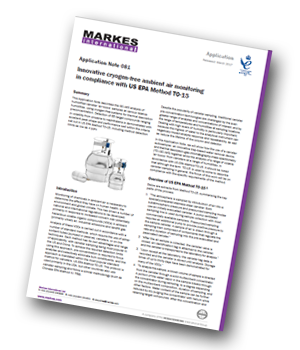Markes International has produced an application note describing the GC–MS analysis of humidified canister ‘air toxics’ samples at various relative humidities, using cryogen-free systems for thermal desorption preconcentration. Detection of 65 target compounds ranging in volatility from propene to naphthalene is demonstrated with excellent peak shape and performance well within the criteria set out in US EPA Method TO-15, including method detection limits as low as 4 pptv.
 Introduction
Introduction
Monitoring of chemicals in ambient air is necessary to determine the effect they have on human health, the environment and global climate. This has driven a number of national and international regulations to be developed, primarily in response to increased concern over potentially hazardous volatile organic compounds (VOCs) in ambient (primarily urban) air, industrial emissions and landfill gas. Analysis of these VOCs is carried out in accordance with a number of standard methods, which require the use of either sorbent tubes (pumped or passive), canisters, or on-line techniques. Each method has its own advantages and range of applicability, with canister sampling being most popular in the US and China. To achieve the required detection limits using this approach, pre-concentration is required to focus analytes and selectively eliminate bulk constituents, and this approach is mandated within the most popular standard method for canisters, US EPA Method TO-15. This protocol is used primarily in the USA, but other countries also use canister sampling and follow a similar methodology (such as Chinese EPA Method HJ 759).
Analytical Equipment
The analytical system used for this study was a CIA Advantage™ canister autosampler with a Kori-xr™ water condenser and UNITY-xr™ thermal desorber, coupled to a GC–MS system.
Conclusions
In this application note it is shown how the use of a canister autosampler, an innovative trap-based water removal device, and thermal desorption–gas chromatography–mass spectrometry
(TD–GC–MS) together provide an effective method for the analysis of a range of volatile ‘air toxics’ from canisters at a range of humidities. The CIA Advantage–Kori-xr–UNITY-xr re‑concentration system described allows confident GC–MS canister analysis of ‘air toxics’ in humid environments, in accordance with US EPA Method TO-15.
